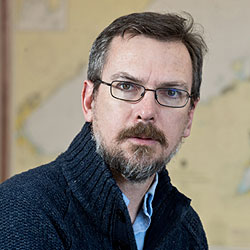
- This event has passed.
9/20/19: Jay Austin

Please join us for a Great Lakes Seminar Series presentation:
Time: 1:30-2:30 pm EDT
Location: NOAA Great Lakes Environmental Research Laboratory, Lake Superior Hall
Presenter: Jay Austin, University of Minnesota – Duluth
Title: What does it really mean for a lake to “turn over”? Radiatively driven convection in a deep lake.
Abstract: Due to the existence of the temperature of maximum density for freshwater (3.98C), springtime heating of a freshwater lake from incident sunlight can result in a process called radiatively-driven convection, where heating at the surface of the lake makes surface waters denser, resulting in full water-column convection. In a deep lake like Lake Superior, this process can dominate the circulation of the lake for two to three months every year, and controls the vertical redistribution of physical, biological, and geochemical properties in the lake during this period. Characteristic features of the convection cells produced are discerned from a set of observations made in Lake Superior over the last several years, from autonomous underwater gliders, turbulence profilers, and moorings, including a large, two-point mooring that consisted of a two-dimensional array of thermistors 180m on a side. Glider data suggests that warm water produced near the surface convect into the lake in chimney-like structures with lateral scales on the order of 10m, and the cells themselves have lateral scales on the order of 100m. Observed vertical velocities on the order of 1cm/s. Temperature anomalies on the order of 0.1K build up during the day, and the water column tends to fully homogenize each night. Developing a better understanding of the dynamics of this convective process is essential to our understanding of the annual development of deep, dimictic lakes.
Bio: Dr. Austin is a Professor at the Large Lakes Observatory and in the Department of Physics and Astronomy at the University of Minnesota, Duluth. He is a Physical Limnologist with broad interests, studying a wide range of phenomenology on large lakes around the world. His interests include, but are not limited to, thermal structure, the role of ice, climate change impacts, acoustics, and convective processes. He is primarily an observationalist, utilizing moorings, autonomous gliders and autonomous profilers as well as historical data to study lake processes. He also utilizes numerical modeling techniques, largely to study the sensitivity of lake systems to climate change. He is also interested in pedagogy and outreach. Dr. Austin’s undergraduate degrees in Physics and Math are from Cal Poly, San Luis Obispo, and his PhD (1999) is from the MIT/Woods Hole Oceanographic Institution Joint Program in Physical Oceanography. He has been at UMD since 2005.
**Registration is not required, however please note important visitor information**
Important Visitor Information
All in-person seminar attendees are required to receive a visitor badge from the front desk at the NOAA Great Lakes Environmental Research Laboratory facility. Seminar attendees need to present a valid U.S. photo ID or green card. If you are a Foreign National, advance notification of at least 48 hours is needed so that security guidelines are followed. You will need to present your passport (a copy will NOT work). For questions regarding building access, or assistance in obtaining Foreign National clearance, please call 734-741-2394. Email contact: [email protected]
_____________________________________________________
Questions? Contact Mary Ogdahl: [email protected]
Visit ciglr.seas.umich.edu for more information.


